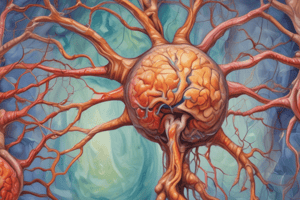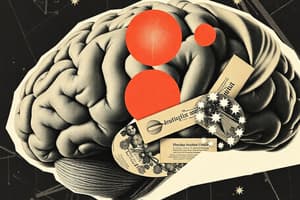Podcast
Questions and Answers
Which neurotransmitter is involved in learning, memory, and motor control?
Which neurotransmitter is involved in learning, memory, and motor control?
- Norepinephrine
- Acetylcholine (correct)
- Glutamate
- Dopamine
What is the primary function of GABA?
What is the primary function of GABA?
- To regulate sleep and wakefulness
- To induce anxiety and insomnia
- To maintain brain function balance (correct)
- To excite cells to death
What is the effect of excess glutamate transmission?
What is the effect of excess glutamate transmission?
- Induces anxiety and insomnia
- Regulates sleep and wakefulness
- Enhances learning and memory
- Excitotoxicity, leading to cell death (correct)
Which neurotransmitter is involved in pleasure, addiction, and motor dysfunction?
Which neurotransmitter is involved in pleasure, addiction, and motor dysfunction?
What is the role of serotonin in the brain?
What is the role of serotonin in the brain?
Which neurotransmitter is active during wakefulness and decreased during sleep?
Which neurotransmitter is active during wakefulness and decreased during sleep?
What is the effect of unchecked acetylcholine on Parkinson's disease symptoms?
What is the effect of unchecked acetylcholine on Parkinson's disease symptoms?
What is the role of norepinephrine in the brain?
What is the role of norepinephrine in the brain?
What is the role of tryptophan in the brain?
What is the role of tryptophan in the brain?
What is the effect of non-selective histamine antagonists like diphenhydramine?
What is the effect of non-selective histamine antagonists like diphenhydramine?
What is the role of norepinephrine in descending pain modulation?
What is the role of norepinephrine in descending pain modulation?
What is the typical progression of Myasthenia Gravis?
What is the typical progression of Myasthenia Gravis?
What is the characteristic of a lower motor neuron lesion?
What is the characteristic of a lower motor neuron lesion?
What is the result of an injury to the cerebellum?
What is the result of an injury to the cerebellum?
What is the effect of endogenous opioids on pain?
What is the effect of endogenous opioids on pain?
What is the characteristic of an upper motor neuron lesion?
What is the characteristic of an upper motor neuron lesion?
Flashcards are hidden until you start studying
Study Notes
Neurotransmitters
- Glutamate and GABA (Gamma-aminobutyric acid) are neurotransmitters that maintain brain function balance
- Glutamate is excitatory and found in all cells and tissues, while GABA is inhibitory
- Excess glutamate can lead to excitotoxicity, causing cell death
- Glutamate and GABA transmission can be mediated by ionotropic and metabotropic receptors
Glutamate
- Glutamate is an excitatory neurotransmitter
- Glutamate excitotoxicity can occur due to excess glutamate, leading to cell death
- States of hypoxia and ischemia (stroke and TBI) can enhance glutamate's excitatory effects
GABA
- GABA is an inhibitory neurotransmitter
- GABA-A receptors are ionotropic, while GABA-B receptors are metabotropic
- GABA transmission is involved in anxiety, insomnia, and muscle relaxation
- GABA transmission can be enhanced by drugs to treat anxiety and insomnia
Acetylcholine
- Acetylcholine is a neurotransmitter involved in learning, memory, and motor control
- Acetylcholine is a primary rapid transmitter in the brain
- Acetylcholine receptors can be ionotropic (fast) or metabotropic (slow)
- Combined with dopamine, acetylcholine controls motor function, specifically smooth motor function (e.g., handwriting)
Dopamine
- Dopamine is involved in pleasure, addiction, and motor dysfunction
- Dopamine receptors are metabotropic (slow)
- Deterioration of dopamine leads to motor dysfunction and is associated with Parkinson's disease
- Dopamine is involved in motivation, arousal, and reward processing
Norepinephrine (NE)
- Norepinephrine is a neurotransmitter involved in attention, arousal, and motivation
- Norepinephrine receptors are metabotropic (slow)
- Suppression of norepinephrine can lead to sedation (e.g., clonidine)
- Norepinephrine is involved in modulation of pain perception
Serotonin (5-HT)
- Serotonin is a neurotransmitter involved in mood regulation, appetite, and sleep
- Serotonin receptors are metabotropic (with one exception: 5-HT3)
- Increased serotonin levels in the brain can treat depression and anxiety
- Selective serotonin reuptake inhibitors (SSRIs) increase serotonin levels in the brain
Histamine
- Histamine is a neurotransmitter involved in arousal, motivation, and modulation of pain
- Histamine receptors are metabotropic
- Histamine is active during wakefulness and decreased during sleep
- Non-selective histamine antagonists (e.g., diphenhydramine) can cause sleepiness
Peptides
- Peptides are neurotransmitters involved in modulation of behavior states
- Peptides interact across the CNS and PNS
- Peptides are metabotropic
Pain Modulation
- Descending pain modulation involves the use of neurotransmitters norepinephrine and serotonin
- Norepinephrine and serotonin can decrease pain perception
- Glutamate can ascend pain signals to the spinal cord, leading to rapid action to stop painful stimuli
- Pain sensitization can occur due to inflammation, leading to hyperalgesia and allodynia
Myasthenia Gravis
- Myasthenia gravis is an autoimmune disorder that attacks acetylcholine receptors
- The disorder leads to muscle weakness and fatigue, often beginning with facial muscles
- Symptoms can progress to dysphagia, impaired speech, and impaired gait
Lower and Upper Motor Neuron Lesions
- Lower motor neuron lesions affect the brainstem and spinal cord, leading to weakness, muscle atrophy, and hyporeflexia
- Upper motor neuron lesions affect the motor cortex, leading to increased spasticity, hyperreflexia, and weakness
Dysmetria and Dysdiadochokinesia
- Dysmetria is a movement disorder characterized by fluctuations in movement amplitude
- Dysdiadochokinesia is a movement disorder characterized by an inability to conduct rapid alternating movements
- Both disorders are associated with cerebellar dysfunction, which can result from injury, stroke, tumors, or congenital conditions
Studying That Suits You
Use AI to generate personalized quizzes and flashcards to suit your learning preferences.




